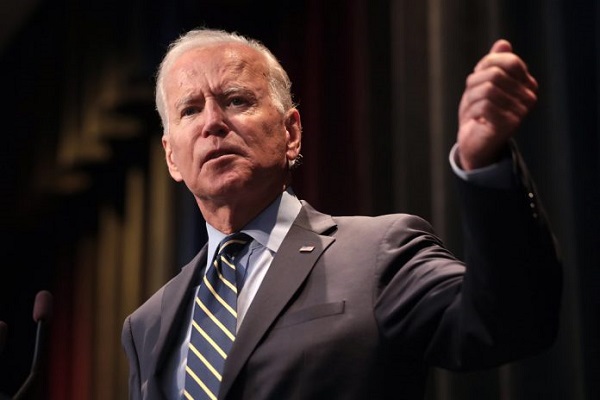Energy
Biden Talks Tough About NATO, but His Energy Policies Tell Different Story

From Heartland Daily News
By Steven Bucci of the Daily Signal
That faction must decide which is the priority: stopping Putin and helping our friends in Europe permanently leave the sway of Russia’s energy extortion, or crippling American energy companies to virtue-signal how “green” America can become. You can’t really have both.
President Joe Biden, host of the 75th anniversary NATO Summit in Washington that ends Thursday, last week claimed to ABC News anchor George Stephanopoulos that he “put NATO together.”
Trying to find a charitable spin on this claim, let’s assume Biden means that he helped NATO stand stronger against Russian President Vladimir Putin in the crisis over Russia’s 2022 invasion of Ukraine.
Biden certainly didn’t put together NATO, founded in 1949, regardless of his recollection. In that context, it makes one wonder about the purpose and intent behind Biden’s energy policies and their implications for our NATO allies.
The president’s words imply one thing, but his actions are exactly the opposite. At this week’s NATO Summit, America’s allies should have denounced Biden’s energy policies for benefiting Russia.
For example, if we investigate the Biden administration’s policies on liquefied natural gas, we find that rather than supporting NATO against Russia, they clearly enable Russia and disadvantage our allies. Biden’s imposition this year of an export moratorium on liquefied natural gas, or LNG, has hampered U.S. companies that are trying to aid our allies by weaning them off dependence on Russian natural gas.
You can debate Biden’s words (and his faulty memory), but his policies are simply dead wrong.
First, let’s look at Biden’s disastrous pause in exports of liquefied natural gas. The Energy Department has stopped new permits for such exports to Europe and Asia, which has led to price volatility and no assurance of reliable sources for our allies to meet their energy demands.
A federal judge in Louisiana recently reversed Biden’s moratorium. That action could eventually help allow private sector companies in the U.S. to support our allies in Europe and Ukraine.
One example of note includes Ukraine and Venture Global, an American company that wants to come to the rescue by supplying Ukraine and Europe with liquefied natural gas to help them reduce their dependence on Russian gas. Biden’s continued pause had stood in the way.
The judge in Louisiana noted that the Biden administration’s suspension of LNG exports conflicts with settled law such as the Natural Gas Act, which directs the Energy Department to “ensure expeditious completion” of permit reviews.
Biden’s LNG export moratorium also violates the Administrative Procedure Act, since there never was a congressional direction that the Energy Department impose it.
All of this is a clear conflict (again) between responsible policy and the extremist green faction of Biden’s Democratic Party and his administration. That faction must decide which is the priority: stopping Putin and helping our friends in Europe permanently leave the sway of Russia’s energy extortion, or crippling American energy companies to virtue-signal how “green” America can become.
You can’t really have both. And yet, ironically, new evidence demonstrates that U.S. exports of liquefied natural gas represent a climate-conscious solution. A recent Berkeley Research Group report found that these exports result in lower greenhouse gas emissions than does natural gas supplied by competing countries, and much lower emissions compared with coal.
The second example of this dangerous conflict is Biden’s support for a Middle East pipeline owned by the Russians. Here at least the president’s position seems to be nuanced, since a greater supply of oil could help lower energy prices.
Biden’s State Department has strongly supported restarting an oil pipeline that has been offline because of a political dispute among Kurdistan, Iran, and Turkey. Unfortunately, the pipeline is 60% owned by Rosneft, an oil company that itself is owned by the Russian state.
Oh, and a point I skipped above: We shouldn’t be helping Iran or a hostile Turkey to control or influence significant energy in any way. All this defies logic.
It’s obvious that Biden wants cheaper energy. Every president does in an election year. That said, why is the State Department supporting reopening a Middle East pipeline that’s majority-owned by the Kremlin after the Biden administration canceled infrastructure projects here at home?
The administration’s priorities are entirely misplaced.
There is a path forward. It involves reinforcing American leadership in domestic energy production. Instead of playing into the hands of our adversaries (Russia, Iran, and Venezuela), the Biden administration needs to change course and open more access to American oil and gas production.
That starts by permanently ending the suspension on LNG exports, ending the moratorium of oil and gas exploration on federal lands, ending unprecedented restrictions on offshore oil and gas leasing, ceasing resistance to the Canadian Enbridge Pipeline 5, and restarting canceled pipeline projects such as Keystone XL.
America’s energy resources are the envy of the world and should be leveraged to protect our citizens and our allies.
U.S. energy exports strengthen our competitive edge against China, Russia, and other hostile regimes. They also produce high-paying jobs at home and lessen dependence on any foreign source.
If America really wants to help Ukraine and be a leader in NATO, this is a path that will be consistent, effective, and inexpensive compared with direct financial or material support.
The green energy activists will hate it, but simply put: They’re wrong.
Steven Bucci is a visiting fellow in the Phillip N. Truluck Center for Leadership Development.
Originally published by The Daily Signal. Republished with permission.
Business
Climate Climbdown: Sacrificing the Canadian Economy for Net-Zero Goals Others Are Abandoning

By Gwyn Morgan
Canada has spent the past decade pursuing climate policies that promised environmental transformation but delivered economic decline. Ottawa’s fixation on net-zero targets – first under Justin Trudeau and now under Prime Minister Mark Carney – has meant staggering public expenditures, resource project cancellations and rising energy costs, all while failing to
reduce the country’s dependence on fossil fuels. Now, as key international actors reassess the net-zero doctrine, Canada stands increasingly alone in imposing heavy burdens for negligible gains.
The Trudeau government launched its agenda in 2015 by signing the Paris Climate Agreement aimed at limiting the forecast increase in global average temperature to 1.5°C by the end of the century. It followed the next year with the Pan-Canadian Framework on Clean Growth and Climate Change that imposed more than 50 measures on the economy, key among them a
carbon “pricing” regime – Liberal-speak for taxes on every Canadian citizen and industry. Then came the 2030 Emissions Reduction Plan, committing Canada to cut greenhouse gas emissions to 40 percent below 2005 levels by 2030, and to achieve net-zero by 2050. And then the “On-Farm Climate Action Fund,” the “Green and Inclusive Community Buildings Program” and the “Green Municipal Fund.”
It’s a staggering list of nation-impoverishing subsidies, taxes and restrictions, made worse by regulatory measures that hammered the energy industry. The Trudeau government cancelled the fully-permitted Northern Gateway pipeline, killing more than $1 billion in private investment and stranding hundreds of billions of dollars’ worth of crude oil in the ground. The
Energy East project collapsed after Ottawa declined to challenge Quebec’s political obstruction, cutting off a route that could have supplied Atlantic refineries and European markets. Natural gas developers fared no better: 11 of 12 proposed liquefied natural gas export terminals were abandoned amid federal regulatory delays and policy uncertainty. Only a single LNG project in Kitimat, B.C., survived.
None of this has had the desired effect. Between Trudeau’s election in 2015 and 2023, fossil fuels’ share of Canada’s energy supply actually increased from 75 to 77 percent. As for saving the world, or even making some contribution towards doing so, Canada contributes just 1.5 percent of global GHG emissions. If our emissions went to zero tomorrow, the emissions
growth from China and India would make that up in just a few weeks.
And this green fixation has been massively expensive. Two newly released studies by the Fraser Institute found that Ottawa and the four biggest provinces have either spent or foregone a mind-numbing $158 billion to create just 68,000 “clean” jobs – an eye-watering cost of over $2.3 million per job “created”. At that, the green economy’s share of GDP crept up only 0.3
percentage points.
The rest of the world is waking up to this folly. A decade after the Paris Agreement, over 81 percent of the world’s energy still comes from fossil fuels. Environmental statistician and author Bjorn Lomborg points out that achieving global net-zero by 2050 would require removing the equivalent of the combined emissions of China and the United States in each of the next five
years. “This puts us in the realm of science fiction,” he wrote recently.
In July, the U.S. Department of Energy released a major assessment assembled by a team of highly credible climate scientists which asserted that “CO 2 -induced warming appears to be less damaging economically than commonly believed,” and that aggressive mitigation policies might be “more detrimental than beneficial.” The report found no evidence of rising frequency or severity of hurricanes, floods, droughts or tornadoes in U.S. historical data, while noting that U.S. emissions reductions would have “undetectably small impacts” on global temperatures in any case.
U.S. Energy Secretary Chris Wright welcomed the findings, noting that improving living standards depends on reliable, affordable energy. The same day, the Environmental Protection Agency proposed rescinding the 2009 “endangerment finding” that had designated CO₂ and other GHGs as “pollutants.” It had led to sweeping restrictions on oil and gas development and fuelled policies that the current administration estimates cost the U.S. economy at least US$1 trillion in lost growth.
Even long-time climate alarmists are backtracking. Ted Nordhaus, a prominent American critic, recently acknowledged that the dire global warming scenarios used by the Intergovernmental Panel on Climate Change rely on implausible combinations of rapid population growth, strong economic expansion and stagnant technology. Economic growth typically reduces population increases and accelerates technological improvement, he pointed out, meaning emissions trends will likely be lower than predicted. Even Bill Gates has tempered his outlook, writing that climate change will not be “cataclysmic,” and that although it will hurt the poor, “it will not be the only or even the biggest threat to their lives and welfare.” Poverty and disease pose far greater threats and resources, he wrote, should be focused where they can do the most good now.
Yet Ottawa remains unmoved. Prime Minister Carney’s latest budget raises industrial carbon taxes to as much as $170 per tonne by 2030, increasing the competitive disadvantage of Canadian industries in a time of weak productivity and declining investment. These taxes will not measurably alter global emissions, but they will deepen Canada’s economic malaise and
push production – and emissions – toward jurisdictions with more lax standards. As others retreat from net-zero delusions, Canada moves further offside global energy policy trends – extending our country’s sad decline.
The original, full-length version of this article was recently published in C2C Journal.
Gwyn Morgan is a retired business leader who has been a director of five global corporations.
Carbon Tax
Carney fails to undo Trudeau’s devastating energy policies

From the Fraser Institute
By Tegan Hill and Elmira Aliakbari
On the campaign trail and after he became prime minister, Mark Carney has repeatedly promised to make Canada an “energy superpower.” But, as evidenced by its first budget, the Carney government has simply reaffirmed the failed plans of the past decade and embraced the damaging energy policies of the Trudeau government.
First, consider the Trudeau government’s policy legacy. There’s Bill C-69 (the “no pipelines act”), the new electricity regulations (which aim to phase out natural gas as a power source starting this year), Bill C-48 (which bans large oil tankers off British Columbia’s northern coast and limit Canadian exports to international markets), the cap on emissions only from the oil and gas sector (even though greenhouse gas emissions have the same effect on the environment regardless of the source), stricter regulations for methane emissions (again, impacting the oil and gas sector), and numerous “net-zero” policies.
According to a recent analysis, fully implementing these measures under Trudeau government’s emissions reduction plan would result in 164,000 job losses and shrink Canada’s economic output by 6.2 per cent by the end of the decade compared to a scenario where we don’t have these policies in effect. For Canadian workers, this will mean losing $6,700 (annually, on average) by 2030.
Unfortunately, the Carney government’s budget offers no retreat from these damaging policies. While Carney scrapped the consumer carbon tax, he plans to “strengthen” the carbon tax on industrial emitters and the cost will be passed along to everyday Canadians—so the carbon tax will still cost you, it just won’t be visible.
There’s also been a lot of buzz over the possible removal of the oil and gas emissions cap. But to be clear, the budget reads: “Effective carbon markets, enhanced oil and gas methane regulations, and the deployment at scale of technologies such as carbon capture and storage would create the circumstances whereby the oil and gas emissions cap would no longer be required as it would have marginal value in reducing emissions.” Put simply, the cap remains in place, and based on the budget, the government has no real plans to remove it.
Again, the cap singles out one source (the oil and gas sector) of carbon emissions, even when reducing emissions in other sectors may come at a lower cost. For example, suppose it costs $100 to reduce a tonne of emissions from the oil and gas sector, but in another sector, it costs only $25 a tonne. Why force emissions reductions in a single sector that may come at a higher cost? An emission is an emission regardless of were it comes from. Moreover, like all these policies, the cap will likely shrink the Canadian economy. According to a 2024 Deloitte study, from 2030 to 2040, the cap will shrink the Canadian economy (measured by inflation-adjusted GDP) by $280 billion, and result in lower wages, job losses and a decline in tax revenue.
At the same time, the Carney government plans to continue to throw money at a range of “green” spending and tax initiatives. But since 2014, the combined spending and forgone revenue (due to tax credits, etc.) by Ottawa and provincial governments in Ontario, Quebec, British Columbia and Alberta totals at least $158 billion to promote the so-called “green economy.” Yet despite this massive spending, the green sector’s contribution to Canada’s economy has barely changed, from 3.1 per cent of Canada’s economic output in 2014 to 3.6 per cent in 2023.
In his first budget, Prime Minister Carney largely stuck to the Trudeau government playbook on energy and climate policy. Ottawa will continue to funnel taxpayer dollars to the “green economy” while restricting the oil and gas sector and hamstringing Canada’s economic potential. So much for becoming an energy superpower.
-

 Alberta2 days ago
Alberta2 days agoNational Crisis Approaching Due To The Carney Government’s Centrally Planned Green Economy
-

 Carbon Tax1 day ago
Carbon Tax1 day agoCarney fails to undo Trudeau’s devastating energy policies
-

 Business1 day ago
Business1 day agoThe UN Pushing Carbon Taxes, Punishing Prosperity, And Promoting Poverty
-

 Agriculture2 days ago
Agriculture2 days agoFederal cabinet calls for Canadian bank used primarily by white farmers to be more diverse
-

 Health1 day ago
Health1 day agoNEW STUDY: Infant Vaccine “Intensity” Strongly Predicts Autism Rates Worldwide
-

 Business1 day ago
Business1 day agoClimate Climbdown: Sacrificing the Canadian Economy for Net-Zero Goals Others Are Abandoning
-

 Great Reset2 days ago
Great Reset2 days agoCanadian government forcing doctors to promote euthanasia to patients: report
-

 Health15 hours ago
Health15 hours agoCDC’s Autism Reversal: Inside the Collapse of a 25‑Year Public Health Narrative


